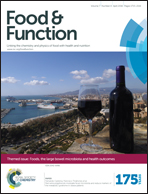Asiatic acid attenuated apoptotic and inflammatory stress in the striatum of MPTP-treated mice
Abstract
The effects of post-treatments with asiatic acid (AA) at 20, 40 or 80 mg per kg BW per day against apoptotic, oxidative and inflammatory injury in the striatum of 1-methyl-4-phenyl-1,2,3,6-tetrahydropyridine (MPTP)-treated mice were examined. The results showed that AA supplements at 40 and 80 mg per kg BW per day increased AA deposit in the striatum, increased glutathione content and decreased reactive oxygen species production in the striatum. AA supplements at 20–80 mg per kg BW per day dose-dependently lowered striatal levels of nitric oxide, 3-nitrotyrosine, interleukin (IL)-1beta, IL-6, tumor necrosis factor-alpha and prostaglandin E2. AA supplements at 40 and 80 mg per kg BW per day down-regulated striatal p47phox and gp91phox expression; but, at three test doses suppressed striatal expression of inducible nitric oxide synthase and cyclooxygenase-2. AA post-treatments at 40 and 80 mg per kg BW per day enhanced Bcl-2 expression, and lowered Bax, apoptosis-inducing factor and caspase-3 expression in the striatum. AA at 20–80 mg per kg BW per day up-regulated striatal tyrosine hydroxylase expression, and suppressed Toll-like receptors (TLR)2 and nuclear factor kappa B p65 expression. AA treatments at 40 and 80 mg per kg BW per day decreased striatal expression of α-synuclein and TLR4, increased striatal levels of dopamine, brain-derived nerve growth factor and glial cell line-derived neurotrophic factor. These novel findings suggest that asiatic acid is a potent nutraceutical agent against the progression of Parkinson's disease.


 Please wait while we load your content...
Please wait while we load your content...